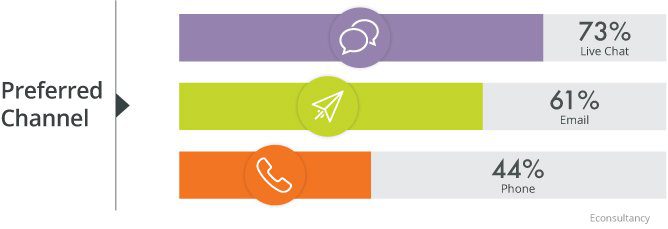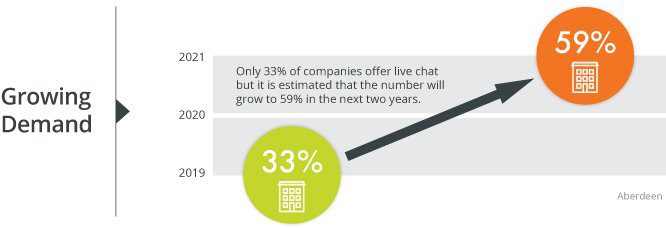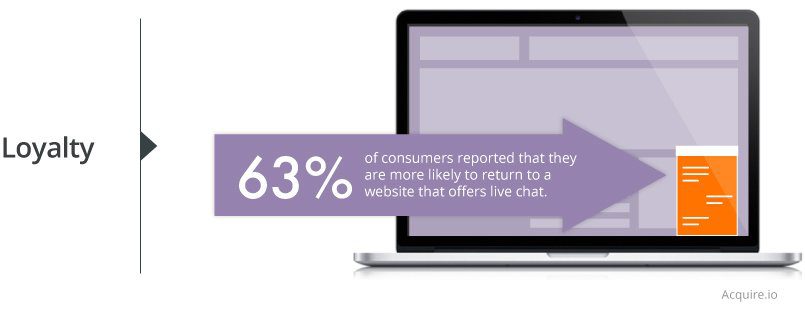If you are listening to the voice of the customer, then you should be able to hear what it is saying. In service circles, that voice is speaking volumes about chat. Study after study shows that chat is a preferred channel among consumers. They find it more engaging, more immediate, and, when done well, more personalized. But, and this is critical, customers want live chat with engaged agents, not bots, not impersonal scripts, and not necessarily the instant pop-ups that appear within seconds of landing on a website.
This point is the subject of some debate. According to Gartner, chatbots will become the primary service channel for about 25% of all organizations by 2027. And corresponding data says nearly three-quarters of customers are okay with bots when seeking answers to easy questions. As we have written before, having mature DIY tools is part of an effective support strategy, but the issue here is not one of tools, it’s one of application. Self-service has a place, much like fast food has a place; neither is designed to be the end-all approach.
Speed vs. Quality

As it turns out, the time it takes for an agent to respond is not nearly as important as what follows. Customers put a premium on the quality of an interaction. They do not mind if service takes a little longer so long as it is thorough and results in a first-contact resolution. In other words, it’s about the experience as a whole – did it reinforce the brand proposition? Did the agent ask probative questions to fully understand a consumer’s issue? While handle time is a standard metric in contact centers, it is not always a good indicator of high agent performance or user satisfaction.
Convenience and Conversion
The convenience factor also applies to agents. While live chat is an avenue for reactive responses, it is also ideal for proactive engagement. Consumers who use it are nearly three times more likely to convert into buyers than those who do not, and they spend more per purchase. Chat is even more valuable when used in tandem with artificial intelligence that looks for specific user behaviors and then alerts agents when those behaviors occur.
For instance, if someone is switching back and forth between two items or two pages, that signals a potential decision point. People will abandon their shopping carts if they are left to linger on a website for too long. To be fair, “too long” is a subjective metric, but engaging sooner rather than later is more effective, especially if a website visitor’s activity is visible. At that point, it becomes very much like the physical store employee who approaches a customer who has browsed for a few minutes and whose body language shows a propensity for purchasing.
The convenience factor is further buoyed by transcripts that can be made available to address misunderstandings or to serve as a record of the interaction and by innovations like our text analysis and customer sentiment tool. This technology parses interactions for the key moments delineating success and missed opportunity. It explores a user’s mindset during an interaction, and the findings are also a tremendous coaching tool for improving agent performance.
Putting It in Context

One reason for that is generational differences in communication preferences. When nearly three-quarters of Gen-X and Millennial customers prefer digital channels to voice, it’s easy to understand why companies are going digital. What should not happen is the either/or choice. Service can and should be provided across multiple channels, so long as you remember that each comes with trade-offs.
The industry standard with phone service is to answer 80% of calls within 20 seconds. That figure can and will vary greatly among industries and does not account for customers’ time on hold. That is an enormous source of frustration that typically does not exist with chat. In addition, phone agents are limited to one call at a time, while a seasoned chat agent can comfortably manage up to three concurrent conversations. That’s quite a productivity enhancement.
The Bottom Line
Higher sales conversions, improved retention, shortened sales cycle, better aftercare, and fewer abandoned shopping carts. Those are just some benefits of making live chat an integral customer service and support channel. Chat is also cost-efficient as agents can handle work with multiple customers simultaneously and often, in a shorter time than phone calls require. Faster issue resolution also helps with staffing levels, as agents can handle a higher workload.
One last number to keep in mind is that 63% of consumers say they are more likely to return to a website that offers chat. This connects to loyalty, which is priceless. Loyal customers are the ones who become brand advocates and key points of future customer referrals. People want real-time communication and live agents best provide that. Automation is not authenticity; bots struggle with personalization. The value behind this channel is self-evident. If you’re not already offering chat, we’ll help you get started.
The Preferred Channel by Customers, Exceptional ROI for Companies
We wanted to provide a simple approach that explains the value of chat to customers and companies. The good news is that it is great for both.
Clearly, chat is the preferred channel for customers, because it’s quick and easy. Your business can benefit from lower costs, increased loyalty, and higher sales. This win-win value demonstrates why there’s growing demand for chat.
The Best Channel for Customers
Why are customers more satisfied with live chat (73% favorable), compared to email (61%), and phone (44%)?

The Answer:
Chat provides a live person with the speed and ease they want. When asked, 79% of customers said they prefer chat because questions are answered quickly; 51% because they could multi-task; and 46% because it’s the most efficient communication method.
If we dive deeper, email has a long turnaround time, which may involve several correspondences. The phone channel provides additional challenges, like finding a company’s phone number, being subjected to an interactive voice response (IVR) system, long wait times, putting up with script reading, and longer overall interaction times. There are too many time-consuming challenges, as compared to chat. Customers want a rapid, simple solution that provides answers they need from a real person.
If customers prefer chat, it begs the question: “Why aren’t many companies providing it?”
Demand for Chat is Growing
Today, it’s estimated that only 33% of companies are offering live chat to their customers.
Chat has been around for years and is a proven channel. GlowTouch believes that most companies haven’t adopted live chat because they don’t fully understand its benefits. Many perceive that it’s difficult to set up and manage.
Although there are different nuances, live chat is similar to phone support. It still uses live agents, queues interactions, and has many comparable metrics. More companies are discovering the ease of chat for customers and their business, which is fueling its recent growth.
Another factor influencing chat’s growth is that customers are going online more frequently, expecting to interact with and purchase from companies. It’s estimated in the next two years that 59% of companies will offer live chat from their websites.

Outstanding ROI for Companies
Customers are telling us they prefer that channel over any other method. Therefore, companies are responding by investing in chat, and they’re realizing tremendous benefits from their efforts.
Chat Costs Less Than Phone Calls
Companies have discovered that chat is a lower cost channel compared to the phone. Typically, live chat costs 50% less.

Two major factors influence cost savings: First, one agent can chat with more than one customer at a time, which is known as concurrent chats. Although we recommend against high multiples of concurrent chats, it‘s very common for an agent to handle two or more chats at a time. This factor can account for most of the cost savings.
A second benefit: Phone calls are usually longer than chats. Shorter interactions mean the same staffing levels can handle many more customers a day—that’s good for the company and the customer.
Chat Improves Customer Loyalty and Sales
It’s proven that customers are more satisfied with chat–and higher satisfaction promotes customer loyalty. Market intelligence states that it costs 10 times more to acquire a customer than keep one. Therefore, customer loyalty is critical to a company’s bottom line.
Another vital live chat statistic: 63% of consumers reported they’re more likely to return to a website that offers live chat. This is another way live chat promotes and reinforces loyalty.

But did you know chat brings tremendous opportunity to also increase sales?
It’s true:
- Customers who use live chat have a 10% increase in average order value.
- Live chat also increases the conversion rate by 40%.

Increased sales are the largest opportunity companies overlook when considering live chat. Don’t leave money on the table. Influencing the right customer behavior is the key to your business. You want to entice them to a first purchase, have them stay with you, and then buy additional products and services from you.
Customers are saying they want live chat–if you give it to them, they will give you more of their business.
Conclusion
It’s easy to see that live chat provides an outstanding return on investment (ROI) for companies. It costs 50% less than phone calls, customers are more satisfied with it, and they reward you with a greater amount of loyalty and sales. Customers say live chat is the easiest and fastest way to interact with a live person.



















































